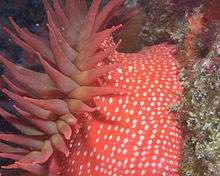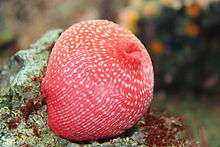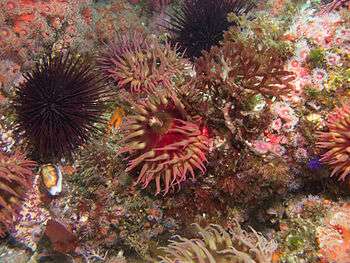Urticina lofotensis
| Urticina lofotensis | |
|---|---|
 | |
| Scientific classification | |
| Kingdom: | Animalia |
| Phylum: | Cnidaria |
| Class: | Anthozoa |
| Order: | Actiniaria |
| Family: | Actiniidae |
| Genus: | Urticina |
| Species: | U. lofotensis |
| Binomial name | |
| Urticina lofotensis (Danielssen, 1890) [1] | |
| Synonyms[1] | |
| |
Urticina lofotensis is a species of sea anemone in the family Actiniidae. It is commonly known as the white-spotted rose anemone or strawberry anemone.[2]
Taxonomy
According to one authority, the populations of Urticina lofotensis found in the Pacific Ocean are not the same species as those in the Atlantic Ocean. They are considered to be conspecific with Cribrinopsis albopunctata, a new species from Kamchatka.[3] The same authority considers that the name Urticina lofotensis is invalid for the species found in European waters and is a junior synonym of Urticina eques.[4] This is not accepted by the World Register of Marine Species [1] nor the Encyclopedia of Life.[5]
Description

Urticina lofotensis has a smooth, red column with vertical rows of white tubercles. In contrast to other similar species, the tubercles are not adhesive and do not normally attract gravel and shell fragments. There are no acontia with stinging nematocysts protruding through the body wall. The oral disk is plain red and the tapering tentacles are red and have no transverse striations. This is a large sea anemone with a diameter of up to 10 cm (4 in) and 15 cm (6 in) length.[2]
Distribution and habitat
Urticina lofotensis is found in the North Atlantic Ocean and the Pacific coast of North America. It occurs between low water mark and a depth of about 15 m (49 ft). It is found on rocks and pilings, in crevices and gullies and favours exposed habitats with fast moving water.[2]
Biology

Urticina lofotensis is dioecious. In California, female ripeness occurs in December as the sea temperature begins to fall. The large eggs, 1,200 µm (0.047 in) in diameter, are produced at intervals, and the release of sperm by the males follows shortly afterwards. In some females, large oocytes also release eggs at other times of year. The gametes emerge through the mouth of the anemone and fertilisation is external. The eggs develop into planula larvae which drift with the current before settling and growing into new individuals.[6]
Ecology
Juveniles of the painted greenling (Oxylebius pictus), a species of fish, have a facultative association with Urticina lofotensis. They are often found among the tentacles or close to the column, especially when resting and inactive at night. According to researcher Joel Elliot, these associations occurred mainly in moderately exposed locations where the sea anemones and fish were both numerous; the large anemone offers the fish protection from predators and provides a safe environment for it to feed on copepods and other small invertebrates that are also associated with the anemone.[7] The research indicated that the fish seemed to be unharmed by the anemone's nematocysts. The anemones themselves were thought not to derive any benefits from the arrangement.[7]
References
- 1 2 3 Urticina lofotensis (Danielssen, 1890) World Register of Marine Species. Retrieved 2011-10-29.
- 1 2 3 Urticina lofotensis (Danielssen, 1890) Walla Walla University. Retrieved 2011-10-29.
- ↑ Sanamyan, N. P.; K. E. Sanamyan (2006). "The genera Urticina and Cribrinopsis (Anthozoa: Actiniaria) from the north‐western Pacific". Journal of Natural History. 40 (7-8): 359–93. doi:10.1080/00222930600703532.
- ↑ Cribrinopsis albopunctata Sanamyan & Sanamyan, 2006 Actiniaria.com. Retrieved 2011-10-29.
- ↑ Urticina lofotensis Encyclopedia of Life. Retrieved 2011-10-29.
- ↑ Wedi, Steven E.; Dapne F. Dunn (1982). "Gametogenesis and reproductive periodicity of the subtidal sea anemone Urticina lofotensis (Coelentrata: Actiniaria) in California". Biological Bulletin. 165: 458–72. doi:10.2307/1541212.
- 1 2 Elliott, Joel (1992). "The role of sea anemones as refuges and feeding habitats for the temperate fish Oxylebius pictus". Environmental Biology of Fishes. 35 (4): 381–400. doi:10.1007/BF00004991.
| Wikimedia Commons has media related to Urticina lofotensis. |